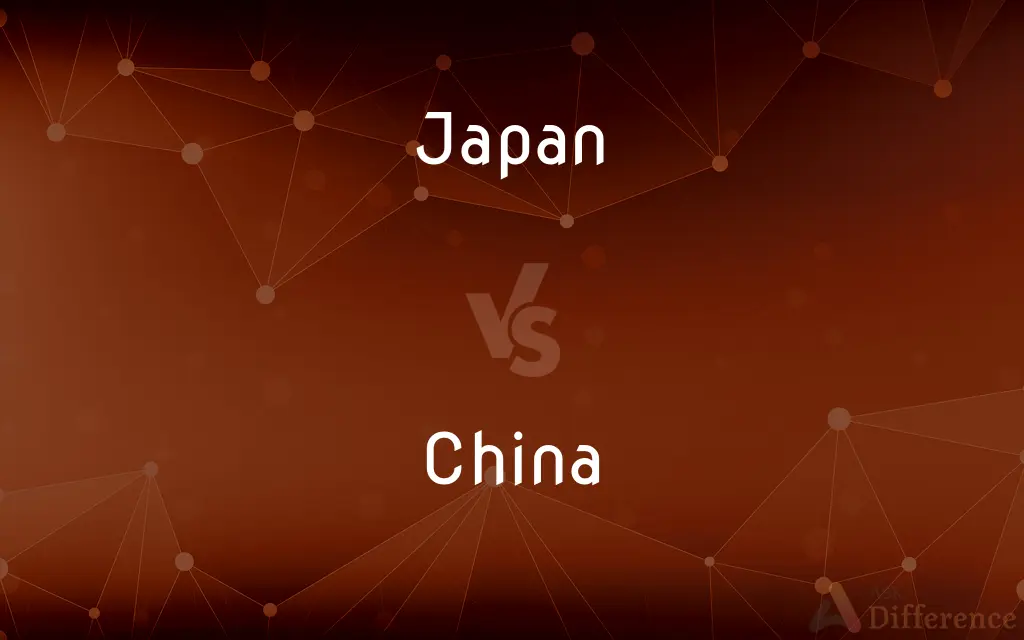Japan vs. China — What's the Difference?
By Maham Liaqat & Fiza Rafique — Updated on April 17, 2024
Japan is an island nation known for its technological advancements and distinct culture, while China is a vast mainland with a rich history and global economic influence.

Difference Between Japan and China
Table of Contents
ADVERTISEMENT
Key Differences
Japan is an archipelago located in East Asia, known for its technological innovation, rich cultural heritage, and a dense population concentrated in urban areas. On the other hand, China is the world's most populous country, with a diverse landscape that ranges from mountain ranges to vast plains, and it has played a significant role in global economics and politics.
Japan's economy is highly developed and the third largest in the world, heavily invested in technology and manufacturing, particularly in electronics and automobiles. Whereas China, with the world’s second-largest economy, has a more diverse industrial base and is a major player in manufacturing and exporting a variety of goods, including electronics and textiles.
The political systems of the two countries are markedly different: Japan operates a parliamentary system with a constitutional monarchy, emphasizing democratic processes. In contrast, China is a socialist state with a single-party system led by the Communist Party, which has significant control over governance.
Culturally, both countries offer rich histories and contributions to art, literature, and cuisine, but with distinct differences. Japanese culture emphasizes minimalism, precision, and respect for tradition, as seen in their tea ceremonies and architecture. Chinese culture, with its roots stretching back thousands of years, is known for its philosophical contributions, such as Confucianism, and significant architectural achievements like the Great Wall.
Socially and demographically, Japan faces challenges related to an aging population and a low birth rate, impacting its labor market and social services. China, while also experiencing demographic shifts, has a larger and more diverse population that presents both opportunities and challenges in terms of labor resources and social policies.
ADVERTISEMENT
Comparison Chart
Geography
Island nation, mountainous terrain
Large, diverse landscapes including mountains, plains, and rivers
Economy
Highly developed, focused on technology and manufacturing
Diverse and large-scale, world leader in manufacturing and export
Political System
Parliamentary democracy with a constitutional monarchy
Socialist one-party state controlled by the Communist Party
Cultural Contributions
Minimalism, tea ceremonies, technology in daily life
Confucianism, historical architecture, diverse culinary heritage
Demographic Challenges
Aging population, low birth rate
Large, diverse population with regional disparities
Compare with Definitions
Japan
Cultural Minimalism.
Japanese art and architecture often emphasize simplicity and subtlety.
China
Culinary Diversity.
Chinese cuisine varies widely from region to region, featuring dishes like Peking duck and Sichuan hotpot.
Japan
Technological Advancement.
Japan is renowned for its innovation in robotics and electronics.
China
Economic Powerhouse.
China's economy is critical to global trade, particularly in manufacturing.
Japan
Constitutional Monarchy.
Japan’s government combines a monarchy with parliamentary governance.
China
Communist Party Leadership.
The Communist Party of China is the sole governing political party.
Japan
Island Nation.
Japan consists of four main islands, making it geographically isolated.
China
Philosophical Contributions.
Chinese philosophy includes significant teachings like Confucianism and Taoism.
Japan
Aging Population.
Japan faces social and economic challenges due to its aging demographics.
China
World's Most Populous Country.
China has a population exceeding 1.4 billion people.
Japan
Japan (Japanese: 日本, Nippon [ɲippoꜜɴ] (listen) or Nihon [ɲihoꜜɴ] (listen)) is an island country in East Asia, located in the northwest Pacific Ocean. It is bordered on the west by the Sea of Japan, and extends from the Sea of Okhotsk in the north toward the East China Sea and Taiwan in the south.
China
China (Chinese: 中国; pinyin: Zhōngguó; lit. 'Central State; Middle Kingdom'), officially the People's Republic of China (Chinese: 中华人民共和国; pinyin: Zhōnghuá Rénmín Gònghéguó; PRC), is a country in East Asia and unitary one-party socialist republic of led by the Communist Party of China (CPC).
Japan
A black enamel or lacquer used to produce a durable glossy finish.
China
High-quality porcelain or other ceramic ware, originally made in China.
Japan
An object decorated with this substance.
China
Porcelain or earthenware used for the table.
Japan
To decorate with a black enamel or lacquer.
China
(uncountable) porcelain china.
It's a china doll.
Japan
To coat with a glossy finish.
China
(uncountable) Chinaware: porcelain tableware.
He set the table with china, cloth napkins, and crystal stemware.
The traditional 20th anniversary gift is china.
Japan
A hard black enamel varnish containing asphalt.
China
Cheaper and lower-quality ceramic and ceramic tableware, distinguished from porcelain.
Japan
Lacquerware.
China
(uncountable) China root, the root of Smilax china (particularly) as a medicine.
Japan
(transitive) To varnish with japan.
China
Syn of cheyney: worsted or woolen stuff.
Japan
To ordain.
China
(countable) China rose, in its various senses.
Japan
Work varnished and figured in the Japanese manner; also, the varnish or lacquer used in japanning.
China
Senseid|en|mate}} {{syn of mate.
All right, me old china?
Japan
Of or pertaining to Japan, or to the lacquered work of that country; as, Japan ware.
China
Tea from China, (particularly) varieties cured by smoking or opposed to Indian cultivars.
Japan
To cover with a coat of hard, brilliant varnish, in the manner of the Japanese; to lacquer.
China
A glazed china marble.
Japan
To give a glossy black to, as shoes.
China
A kind of drum cymbal approximating a Chinese style of cymbal, but usually with Turkish influences.
Japan
A string of more than 3,000 islands east of Asia extending 1,300 miles between the Sea of Japan and the western Pacific Ocean
China
A country in Eastern Asia.
Japan
A constitutional monarchy occupying the Japanese Archipelago; a world leader in electronics and automobile manufacture and ship building
China
China ware, which is the modern popular term for porcelain. See Porcelain.
Japan
Lacquerware decorated and varnished in the Japanese manner with a glossy durable black lacquer
China
A communist nation that covers a vast territory in eastern Asia; the most populous country in the world
Japan
Lacquer with a durable glossy black finish, originally from the orient
China
High quality porcelain originally made only in China
Japan
Coat with a lacquer, as done in Japan
China
A government on the island of Taiwan established in 1949 by Chiang Kai-shek after the conquest of mainland China by the communists led by Mao Zedong
China
Dishware made of china
Common Curiosities
What are some key cultural differences between Japan and China?
Japanese culture is known for its minimalism and precision, while Chinese culture is characterized by its historical depth and philosophical diversity.
What are the geographical distinctions between Japan and China?
Japan is an island nation with limited land area and mountainous terrain, while China encompasses a vast mainland with diverse landscapes.
How does tourism compare between Japan and China?
Both countries are popular tourist destinations, but Japan attracts visitors with its technological marvels and traditional culture, while China offers a rich historical and diverse natural landscape experience.
How does the global influence of Japan and China compare?
Both countries are significant global players, but China has a more substantial impact on the global economy due to its size and extensive manufacturing capabilities.
What is the main political difference between Japan and China?
Japan has a democratic government with a constitutional monarchy, while China is governed by a single-party communist regime.
How do the economies of Japan and China differ?
Japan's economy is highly technological and industrialized, focusing on precision manufacturing, while China has a broad, diverse industrial base and is a global leader in various sectors.
How do Japan and China address their demographic challenges?
Japan is grappling with an aging population and a shrinking workforce, whereas China faces challenges related to its vast population size and regional disparities.
What are the social systems in Japan and China?
Japan’s social system is highly organized with a focus on harmony and respect, whereas China’s social system is structured around community alignment and state control, reflecting its communist governance.
What role does technology play in Japan’s culture and economy?
Technology is integral to both Japan’s cultural identity and its economic strength, particularly in areas like consumer electronics and automotive industries.
What historical contributions has China made to global civilization?
China's contributions include inventions such as paper and gunpowder, as well as architectural marvels like the Great Wall.
Share Your Discovery

Previous Comparison
Equipment vs. Equipments
Next Comparison
Nursery vs. CrecheAuthor Spotlight
Written by
Maham LiaqatCo-written by
Fiza RafiqueFiza Rafique is a skilled content writer at AskDifference.com, where she meticulously refines and enhances written pieces. Drawing from her vast editorial expertise, Fiza ensures clarity, accuracy, and precision in every article. Passionate about language, she continually seeks to elevate the quality of content for readers worldwide.















































